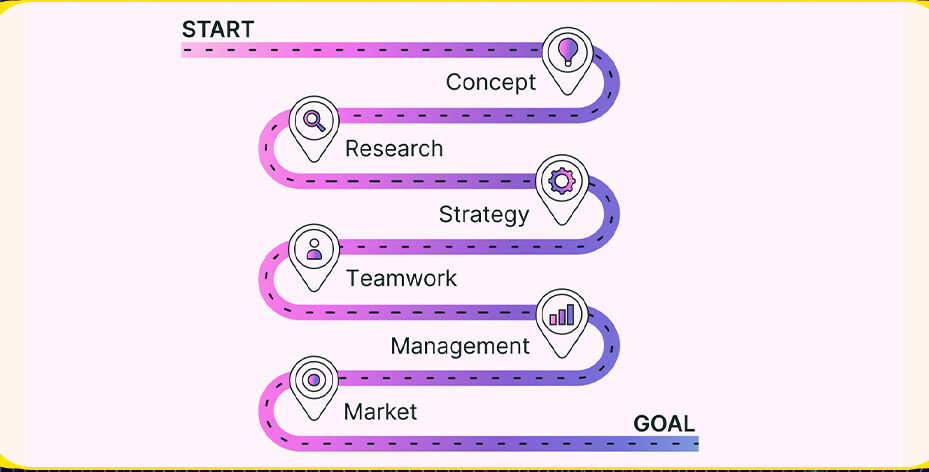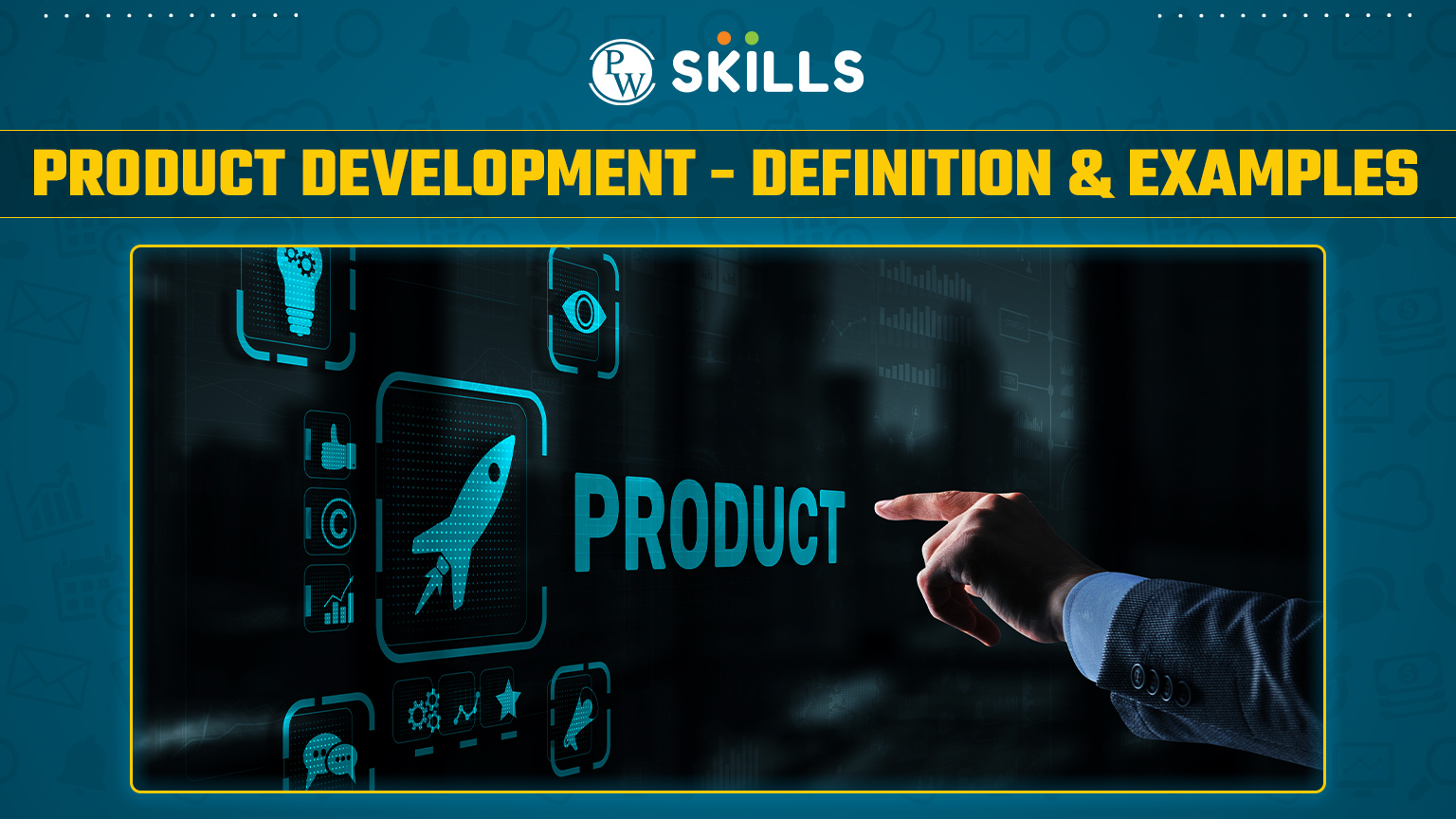What Is Product Development?
Product development is a process that involves several steps of creating a new product or refining an old one. These product development steps include- coming up with ideas, designing, creating, and promoting new or updated products and services. It covers the entire journey of a product, from the initial idea to when it is released in the market.
The goal of product development for businesses is to develop a kind of product that meets customer needs and grows their business by creating greater brand value. For customers, it is about getting a product that is valuable and of good quality.
Not every product that is released by companies will suit all customers, so it is important to identify the right target audience early in the product development process. Companies should do market research at different stages before the initial stage of the product, during its design, and after it is launched.
The Product Development Process
The product development process involves several key stages. While each organization generally follows a different product development process based on their strategy and the type of product they are designing, the most common steps that are generally followed by every company include:

- Identifying a Market Need – Products are made to solve problems. The first step is to find a problem that needs a solution. This can be done by talking to potential customers, conducting surveys, or doing other user research to understand their needs.
- Assessing the Opportunity – Not all problems are big enough to require a product. So, it is important to assess if the problem affects enough people or businesses and if they are willing to pay for a solution, either with money or by sharing their data.
- Creating the Product Concept – The team then brainstorms different ways the product could solve the problem. Some ideas may come easily, while others need more creativity, thought, and team planning.
- Validating the Idea – Before spending too much time on UI designing and prototyping, the team tests whether the idea will work or not. This is a quick check to see if the idea has potential and if it is feasible to build a product based on the following idea.
- Building the Product Plan – Once the idea is good and feasible, the team begins with the plan, called a product roadmap. This outlines the key features and goals that need to be developed first to solve the biggest issues and get users interested.
- Developing a Minimum Viable Product (MVP) – The next step is creating an early version of the product, known as minimum viable product. This early version is released with just essential features for users to try it out.
- Releasing the MVP to Users- The MVP is shared with users to test what response is being generated on the product. The UX team conduct regular surveys and takes feedback to check what needs to be updated. The marketing team on the other hand also tests different marketing approaches, pricing, and gathers feedback on the product.
- Improving Based on Feedback – After the product is in the market, it continues to evolve regularly. The team makes changes based on user feedback and the company’s goals. This process continues until the product reaches the end of its life.
By following these steps, companies can develop products that effectively solve problems and meet user’s needs.
Recommended Course
Product Development Jobs – Who Is Involved In The Product Development Process
In product development, one or more product managers are usually appointed to supervise the entire process. However, these tasks involve collaboration with multiple teams across the organization. Let us read below to understand who all are involved in this product development process:
- Product management: Product managers generally report to product directors and they are responsible for monitoring each team’s progress, making sure they stay on track and meet deadlines. They create a product roadmap that showcase the goals and expectations for each team. Product manager’s role is to coordinate between the teams to avoid issues or delays.
- Engineering: The engineering team consists of software developers and engineers, who handle the technical side of development. If the product is software, the software engineers are responsible for coding, testing, and using development methods like Agile.
- Design: The design teams consist of User Experience and User Interface Designers, they often work closely with engineers as their main role is of creating prototypes by using tools like Figma and identifying potential issues.
- Sales and marketing: These teams consist of sales teams and digital marketing agencies, they basically perform market research and analysis to understand customer interest in the product. They share this information with other teams to enhance the product according to the users demand.
- Stakeholders: External groups such as board members, investors, contractors, and regulatory bodies may need regular updates or even approval before the product can be launched.
Product Development Strategy For Marketing And Business Growth
The product development strategy for marketing and business growth mainly depends upon whether the company is entering a new market or an existing one.
A general product development strategy for marketing includes four key elements, which are also known as the four Ps of marketing: product, price, promotion, and place. The basic meaning of all the P’s is written below for your better understanding of the concept:
- Product: This is about the goods or services that is created by a business to meet the needs of a specific audience. Consider a product that has a high targeted audience and a greater market.
- Price: Pricing is an important factor as it impacts the profit, supply, demand, and overall business strategy. Setting the right price is important for being competitive, attracting customers, and maintaining business profit.
- Promotion: This factor is about how the product is shown to the audience to increase interest. It includes things like ads, marketing campaigns, SEO Hacks, and public relations to show why the product is valuable.
- Place: While some products are sold in physical stores, many are sold online in today’s digital world. The goal is to reach maximum customers wherever they are, whether through a store, website, or a mix of both.
Product Development Examples
Let us understand product development in a better way with the help of a real-life product development example given below:
1. Airbnb
Airbnb’s journey is a prime example of turning a simple idea into a global platform by identifying a gap in the travel industry and using technology.
The key steps involved in the product development process of Airbnb are written below for you reference:
- Idea generation: In 2007, Two roommates, Brian Chesky and Joe Gebbia were struggling to pay rent in San Francisco. This was the time when they came up with the idea of renting out air mattresses in their apartment to visitors who couldn’t find hotel rooms.
- Product technical design: Airbnb’s platform was built using popular web technologies like Ruby on Rails, Python, and JavaScript. This platform helps hosts to list their spaces on the platform so that guests can find a cost-efficient place to stay.
- Concept testing: In 2008, the first guests stayed at Chesky and Gebbia’s apartment during a design conference in San Francisco, validating the concept of short-term room rentals.
- Market entry: By 2009, They took Airbnb beyond local listings as it entered the international market and rapidly grew into a global marketplace for unique accommodation options.
2. Zomato
The second popular example is of a popular food delivery application Zomato. Zomato’s evolution solved the major problem of finding reliable restaurant and food delivery options:
- Idea generation: In 2008, founders Deepender Goyal and Pankaj Chadha noticed that people were struggling to find restaurant menus online. This sparked the idea of creating a platform to make restaurant information easily accessible.
- Product technical design: Zomato’s platform was initially started with a simple website and later expanded into a mobile app built with technologies like PHP and MySQL for scalability. It allowed users to search for restaurants, view menus, and eventually order food online.
- Concept testing: In its early stages, Zomato was started with the name of “foodie-bay” which focused on compiling restaurant menus and reviews of the Delhi-based restaurants. Later, It gained popularity quickly as users found it helpful for deciding where to eat.
- Market entry: In 2011, Zomato rebranded itself and began expanding internationally, starting with Dubai. It later grew into a comprehensive food delivery and restaurant discovery platform across various countries.
Product Development Vs Product Management
People often think of product development and product management as the same field, but in reality, both of these fields have different work to do and are responsible for handling different tasks, let us understand the major difference between these two terms with the help of a table written below:
| Product Development Vs Product Management | ||
| Aspect | Product Development | Product Management |
| Definition | The process of creating, designing, and building a new product. | The process of supervising the strategy, roadmap, and success of a product. |
| Main Focus | They focus on building the actual product or service. | Product management focuses on planning, launching, and managing the product lifecycle. |
| Role | Product development Job roles involves engineers, designers, and marketer who create the product. | They involve product managers who make decisions about the product’s direction. |
| Key Activities | The key activities included in the product development process are- coding, designing, testing, and improving the product. | It includes setting product goals, market research, and working with teams. |
| Objective | Their objective is to create a working product based on specifications. | Their objective is to ensure that the product meets market needs and achieves business goals. |
| Measurement of Success | The success here is based on the product’s quality and functionality. | Success in this field is measured by product timeline and user satisfaction. |
Learn Product Development With PW Skills
Are you aspiring to start your career in the ever-growing field of product development?
If yes, then enroll in our Product Management With Gen AI Course to learn everything related to product management starting from the basics to the more advanced tools and concepts.
This course will provide you with key features like- live interactive classes, daily doubt-clearing sessions, assignments, the flexibility of recorded lectures for students and working professionals, 5+ real-life projects to work on, 100% job assistance guarantee, industry-recognized certification after course completion, and much more.
So what are you waiting for? Visit PWSkills.com today to grab your seat on this exciting journey.
Product Development FAQs
What are the stages of product development?
The stages of product development typically include idea generation, concept development, product design, prototyping, testing, and market launch.
Why is product development important?
Product development is important because it allows companies to innovate, meet customer needs, and stay competitive in the market by offering new or improved products.
How long does product development take?
The time required for product development varies depending on the complexity of the product. It can take anywhere from a few months to several years, based on factors like design, testing, and market research.

